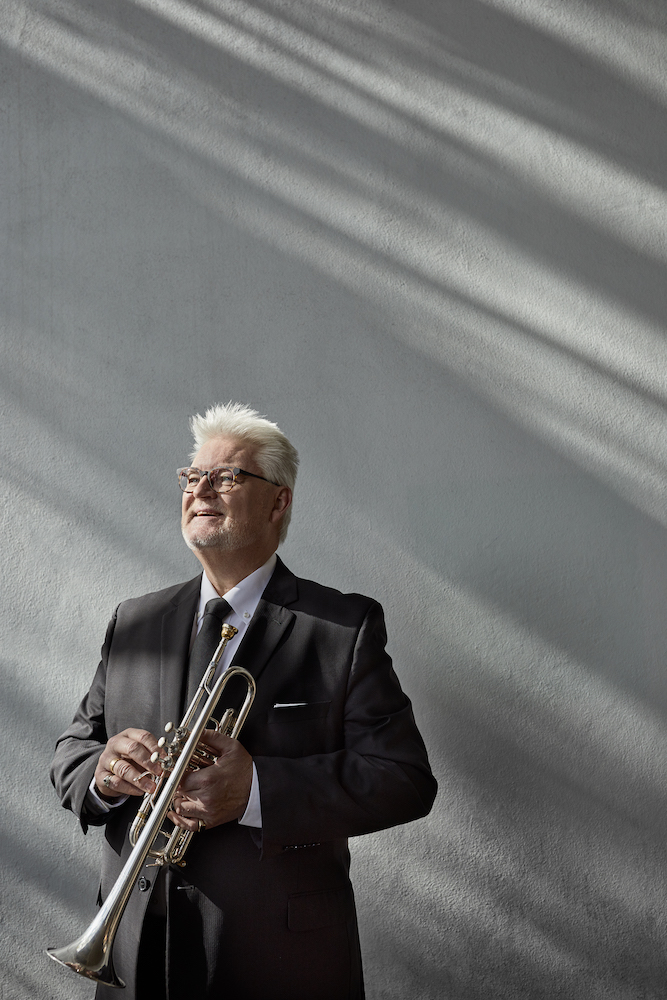The main point of this concert was to celebrate the 40-year career of the Sydney Symphony Orchestra’s Associate Principal Trumpet, Paul Goodchild. He took up the position in 1985, but first played in the trumpet section full time at the age of 18. His father Cliff Goodchild was the orchestra’s Principal Tuba from 1951 to 1987, so it’s a long-standing family connection. Paul played a work composed for a previous SSO Principal Trumpet, John Robertson: the Trumpet Concerto by William Lovelock, an English composer who spent his most productive years in Australia. It was written in 1968 specifically for an RCA recording (the coupling, I recall, was the 1948 Trumpet Concerto by Raymond Hanson). Although the SSO played it for that recording, tonight it was given its first concert performance by the orchestra.
 Sydney Symphony Orchestra Associate Principal Trumpet Paul Goodchild. Photo © Ant Geernaert
Sydney Symphony Orchestra Associate Principal Trumpet Paul Goodchild. Photo © Ant Geernaert
The work is in three movements: the first opening with the kind of jaunty mid-20th century English music we associate with Ealing comedies. A gentle slow movement of a misty, nostalgic tone is followed by a vigorous finale mostly in triple time. The trumpet part is purposely showy and testing throughout, especially a taxing, broad-ranged cadenza in the third movement. Goodchild’s chops were more than up to the task, throwing off the passagework with panache and shining in the occasional lyrical moments. In the slow movement, his expressive phrasing was ideal. I no longer have the old record, but I would say Goodchild’s tone is cleaner – gleaming silver, as opposed to John Robertson’s rich, fat sound that employed a wider vibrato: the difference between two generations, I guess. This was a well-deserved tribute to a beloved musician.
The concert opened with a piece by Australian composer Ella Macens (b. 1991): The Space Between Stars. This atmospheric work (literally so, as the title suggests) revealed great skill in the use of the orchestra, and conductor Jessica Cottis (who was the orchestra’s Assistant Conductor from 2012 to 2014) balanced the sound meticulously. If the Lovelock sounds at times like a British film, Macens’ work has its influences too. Her shifting block harmonies are reminiscent of Vaughan Williams: specifically, the Pastoral Symphony and Sinfonia Antartica; even the Tallis Fantasia at one point where a small group of strings is featured. Her orchestral finesse also reminds me of John Williams: quite a compliment. Macens’ evocative piece will be replaced in the remaining concerts with Finlandia by Sibelius. (Luckily that’s not a work I particularly love, so I’m glad I got to hear this work instead!)
The work in the second half of the concert was Carl Nielsen’s Symphony No 4, The Inextinguishable. This is possibly the trickiest of his six symphonies to pull together (it ties with the Sixth), but Cottis did a creditable job. She judged the ebb and flow well overall, and the famous battle of the timpanists in the final movement was tremendously exciting. (You just can’t get the true impact of that passage in a recording.) If I was to nit-pick, it would be to say that I found the idyllic woodwind dance of the second movement a tad rushed; it could have been more laidback, I thought. The third movement opened with a powerful attack from the violins, but then I felt a loss of energy whenever the score moved from loud to soft. Those ominous, quiet moments need to maintain tension. As I say, that’s nit picking, and it was great to hear this rarely played work (last performed in Sydney in 1987). It was also a pleasure to welcome Cottis back after her triumphs abroad.
The Sydney Symphony Orchestra Celebrates Paul Goodchild is at the Sydney Opera House until May 10











Comments
Log in to join the conversation.